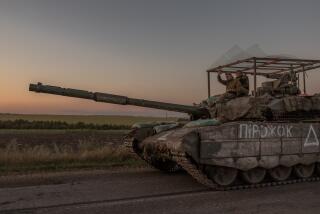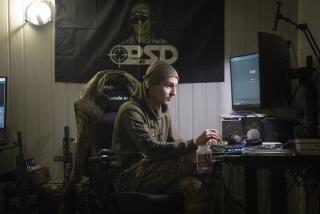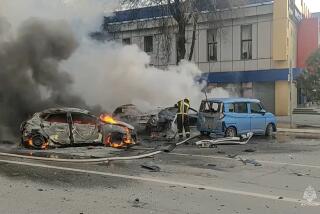The enemies are fake, but Russia’s war games are real. So is the alarm.
Reporting from Moscow — When Russian troops reach the border of the “Republic of Veyshnoria” as scheduled this week, the enclave’s patriotic defenders have pledged, according to their ministry of foreign affair’s Twitter account, to greet defectors from the Russian military with Veyshnorian hospitality: stew, honey, bread and lard.
Veyshnoria is not a real country, but a hypothetical adversary created for this week’s massive joint military exercises conducted by Russia and Belarus. The operation, Zapad 2017, will be one of the largest Russian military exercises since the Cold War.
And while Veyshnoria is make-believe, the hype around the exercises unfolding along NATO’s borders has put Western military alliances on high alert. Concerns are particularly high in neighboring Estonia, Latvia and Lithuania — all former Soviet republics and now NATO members — as well as Poland, whose relations with their former ruling state have grown more tense since the conflict in Ukraine.
The exercises are part of Russia’s routine military training schedule and have taken place every four years since the days of the Red Army. This year, it falls in the territory of Belarus, a former Soviet republic that maintained a military alliance with Moscow even after the breakup of the Soviet Union.
But this year’s drills come at a time when relations between Moscow and the West, particularly the United States, have deteriorated.
Moscow has been flexing its military muscle, sometimes provocatively. Moscow sees the presence of NATO troops in its bordering countries and former Warsaw Pact states and Soviet republics as an encroachment into Russia’s sphere of influence. Russian fighter jets have buzzed U.S. naval vessels in the Baltic and Black Seas.
These exercises will be first Russia has held since Moscow’s annexation of Crimea from Ukraine in 2014, when unmarked Russian troops entered the area ahead of a referendum vote the West denounced. Russian President Vladimir Putin at first denied that they were Russia’s soldiers, but later admitted their presence, saying they had been sent to defend Russian speakers on the Black Sea peninsula. Moscow then backed separatist militias fighting against government forces in eastern Ukraine, an ongoing conflict that has killed more than 10,000, mostly civilians.
Under the Zapad scenario, Veyshnoria is a Western-backed breakaway region in Belarus, with Russian and Belarusian militaries charged with defeating the rebels.
In Belarus, jokes and memes aside, there are some who say it’s alarming to have so many Russian troops there. The government in Minsk, the Belarus capital, is heavily reliant on Russia’s financial largess, which comes in the form of cheap oil and gas, and loans to prop up its largely state-run economy. In return, Moscow has asked for loyalty from Belarus President Alexander Lukashenko. But Putin and Lukashenko have a contentious relationship.
In 2015, a year after Russia’s annexation of Crimea, Russia proposed to put a new airbase in Belarus. There has been speculation that Russia could use the base to set up another annexation scenario in Belarus, or use it to launch military maneuvers against the West. Lukashenko eventually rejected the Kremlin idea.
Russia is a signer of the what is known as the Vienna Document, an agreement between Russia and European nations to alert each other of military drills conducted with 9,000 or more troops. When an exercise involves 13,000 or more troops, the participating nations must allow international observers to attend, according to the agreement.
In the past, Russia has avoided this requirement by declaring fewer troops. Russia has said no more than 12,700 will participate in Zapad. However, military analysts following the preparation ahead of the drills have estimated that Russia could be sending in as many as 100,000 troops, along with tanks, artillery units, aircraft, and other equipment.
Part of this speculation is based on past Russian military exercises, such as in 2009 and 2013, when the estimates of Russian troops were closer to 100,000. In addition, the Russian Ministry of Transport issued a tender last year for 4,000 railway carriages to be used for military maneuvers around the time of Zapad preparations.
“That would be three troops per carriage … that’s fairly luxurious for moving in 13,000 troops,” said Piers Cazalet, a deputy spokesman in NATO’s press office. The real issue is Russia’s lack of transparency with the other signers of the Vienna Document, he said.
NATO and its allies regularly invite Russia to its exercises, and Russia regularly sends observers. But there’s never been a Russian exercise opened up for observation, Cazalet said.
“This is the thing that most concerns us at the moment,” Cazalet said. “This has happened before, it’s an ongoing argument and it’s a shame that we can’t make any progress with it, so I’d categorize it as weary frustration.”
Belarus, a nation of 10 million, has lived under the authoritarianism of Lukashenko for 23 years, earning the landlocked country the title of “Europe’s last dictatorship.” But when the Belarusian Ministry of Defense announced on Aug. 29 that the joint exercises would include the hypothetical Veyshnoria as one of three fictional countries, Belarusian Internet users responded with an enthusiasm typical of the small, former Soviet republic’s dry sense of humor.
Several Twitter accounts and Facebook pages dedicated to Veyshnoria appeared, declaring in Russian, Belarusian and English the virtues of the great land and people of Veyshnoria. A blue, yellow and white flag was created, as was a page where one could sign up for a passport.
It’s not the first time Belarusians have responded to tense political situations with humor. In 2016, Lukashenko made a speech declaring the importance of the country’s booming technology sector, urging his nation “to get undressed and work until you sweat.”
The Internet was filled with photos of naked office workers huddled around computers and conferences tables posted on social media sites with the hashtag #getnakedandwork.
“It’s just probably that we respond more to political situations just because of the political situation in the country,” said Juliana Kornyushko, the editor of the Belarus Feed online news site. “If we could earn from our jokes, we would be rich.”
Twitter: @sabraayres
Ayres is a special correspondent.
ALSO
The end of DACA would be ‘a big win for Mexico,’ foreign secretary says
American rap, local whiskey: Tiny Bhutan guards tradition as it opens up to the world
Why two Israeli Supreme Court rulings could hurt Netanyahu’s governing coalition
More to Read
Sign up for Essential California
The most important California stories and recommendations in your inbox every morning.
You may occasionally receive promotional content from the Los Angeles Times.











